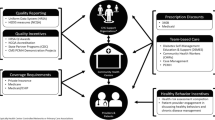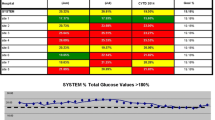Abstract
Background
Implementation of practice change is difficult and large scale implementation is particularly difficult. Among the challenges facing the healthcare system in general and healthcare organizations is the overuse of low value care. Improving medication safety also constitutes an attempt to reduce low value or potentially harmful care. Critical issues of overuse of low value practices and medication safety intersect in overtreatment of diabetes. Specifically, (over)intensive glycemic control increases hypoglycemia risk and morbidity without providing meaningful benefit. Our work indicates that among patients with diabetes who are at high risk for hypoglycemia, potential overtreatment is common. The Choosing Wisely Initiative to reduce low value care led by the American Board of Internal Medicine Foundation recommends not to treat most persons over 65 years of age with medications to reduce the A1c<7.5%. For most physicians this involves a change in practice. We will study the implementation of the Veterans Health Administration's Choosing Wisely Initiative (which includes hypoglycemic safety as a targeted condition) with three specific aims: (1) to assess the overall impact, both intended and unintended, of the Choosing Wisely Initiative to reduce overtreatment of diabetes in especially vulnerable populations; (2) to assess the impact of commitment to quality, teaching intensity, and safety culture on likelihood of overtreatment; and (3) to identify configurations of the implementation strategy, provider characteristics and organizational level factors that are associated with successful reduction of overtreatment rates by comparing high and low performers. Because focus on this initiative could have the unintended consequence of paying less attention to poor glycemic control (A1c>9%), we will also assess undertreatment.
Methods/Design
We will take advantage of a natural experiment and use a Type III Hybrid Design that focuses on study of implementation while at the same time observing and gathering information on clinical interventions and outcomes. This mixed methods study will use longitudinal data and qualitative methods including Qualitative Comparative Analyses.
Discussion
Our multi-paradigm approach to examining potential mechanisms to explain the variation in reduction of rates of overtreatment will contribute to a better understanding of implementation of national dissemination projects and multi-component interventions in complex systems.
Similar content being viewed by others
There are many guides to developing research proposals, and ingredients for implementation research grant proposals have been suggested by Proctor et al.[1]. However, among the challenges facing a new investigator in trying to get research funding is the relative paucity of model grant applications [2, 3]. This is particularly true when the field being entered is a newly developing discipline; implementation science is such a discipline and it is still evolving [4]. Although the publication of protocols from such grant applications has become more common, the actual grant application and its iterations have not. Our goal is not only to provide an example of an implementation research grant application, but also to illustrate this process further by making available the different iterations and the critiques as well. In so doing, we take the process one step further by illustrating how the research team revised the application in response to the critiques. Each funding agency has its own application procedures. These procedures may differ in the details, but are similar. Some require ‘letters of intent’ or ‘concept papers’ while others do not. The revised application is in Additional file 1. We have included in the six other additional files labeled: Additional files 2, 3, 4, 5, 6 and 7.’ This process lasted from May 2013 to March 2014. Of note, in the middle of the process, the funding agency changed its requirements between initial and revised submissions in terms of the length of the narrative, reducing it from 25 to 15 pages.
Proctor et al. identified ten ingredients of a successful implementation research grant proposal [1]. These ingredients are listed in Table 1. All ten ingredients were included in our application to varying degrees. No claims are made that this is the optimal proposal that could be written on the subject, merely that it suffices, i.e., it was good enough to have been funded successfully [5], and they are highlighted in Table 1. It is the hope of the authors that making this material available, with all its imperfections, will foster development of this crucially important discipline. It should also be stated that the process of submission and review resulted in what we believe is a much improved proposal.
References
Proctor EK, Powell BJ, Baumann AA, Hamilton AM, Santens RL: Writing implementation research grant proposals: ten key ingredients. Implement Sci. 2012, 7: 96-10.1186/1748-5908-7-96.
Naylor MD: Special feature: an example of a research grant application: comprehensive discharge planning for the elderly. Res Nurs Health. 1990, 13: 327-347. 10.1002/nur.4770130509.
Annotated R01 Grant Application – NIAID: Bethesda MD, USA: National Institute of Allergy and Infectious Diseases, National Institutes of Health, http://www.niaid.nih.gov/ncn/grants/app/default.htm. 8-21-2013. Accessed 3-24-2014
Bammer G: Integration and implementation sciences: building a new specialization. Ecol Soc. 2005, 10 (2): 6-
Simon HA: The Sciences of the Artificial. 1996, Cambridge, MA: MIT Press, 3
Author information
Authors and Affiliations
Corresponding author
Additional information
Competing interest
The authors declare that they have no competing interests. The views expressed are those of the author and do not represent the views of the Dept. of Veterans Affairs or any other agency.
Authors’ contributions
DA drafted the introductory article. For the additional files constituting the grant application, DA (Principal Investigator) drafted the first version. JL (co-Investigator) drafted the section on qualitative methods. LK (co-Investigator) drafted the section on qualitative comparative analysis. C-LT (co-Investigator) drafted the statistical methods section. PC contributed to the writing. Multiple drafts of the grant application were reviewed and critically by all authors. The authors of the critiques were anonymous. All authors read and approved the final manuscript.
Electronic supplementary material
Rights and permissions
This article is published under an open access license. Please check the 'Copyright Information' section either on this page or in the PDF for details of this license and what re-use is permitted. If your intended use exceeds what is permitted by the license or if you are unable to locate the licence and re-use information, please contact the Rights and Permissions team.
About this article
Cite this article
Aron, D.C., Lowery, J., Tseng, Cl. et al. De-implementation of inappropriately tight control (of hypoglycemia) for health: protocol with an example of a research grant application. Implementation Sci 9, 58 (2014). https://doi.org/10.1186/1748-5908-9-58
Received:
Accepted:
Published:
DOI: https://doi.org/10.1186/1748-5908-9-58




